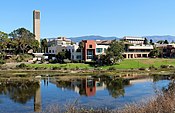This is an old revision of this page, as edited by Logan (talk | contribs) at 01:58, 21 November 2011 (clean up, added orphan tag using AWB). The present address (URL) is a permanent link to this revision, which may differ significantly from the current revision.
Revision as of 01:58, 21 November 2011 by Logan (talk | contribs) (clean up, added orphan tag using AWB)(diff) ← Previous revision | Latest revision (diff) | Newer revision → (diff)| This article is an orphan, as no other articles link to it. Please introduce links to this page from related articles; try the Find link tool for suggestions. (November 2011) |
The Physics Department at the University of California, Santa Barbara has 58 faculty members. It offers academic programs leading to the B.A., B.S., and Ph.D. degrees.
Faculty Awards
As of 2011, the department counts three Nobel Prize winners among its faculty: David Gross (2004, Physics), Alan J. Heeger (2000, Chemistry), and Walter Kohn (1998, Chemistry). Herbert Kroemer, who won the 2000 Nobel Prize in Physics is a member of the Electrical and Computer Engineering and Materials Departments at UC Santa Barbara. The department's faculty includes 13 members of the National Academy of Sciences: Guenter Ahlers, David Awschalom, David Gross, James Hartle, Alan Heeger, Gary Horowitz, Walter Kohn, James Langer, Stanton Peale, Joseph Polchinski, Douglas Scalapino, Boris Shraiman, and Michael Witherell. Awschalom and Heeger are also members of the National Academy of Engineering.
Academics
Undergraduate academics
The standard program, which is in the College of Letters and Science (L&S), leads to either a B.A. or B.S. degree. The B.S. program is for those aiming for a career in physics, while the B.A. is a more flexible program allowing more courses from other areas. Within the B.S. program there are three possible schedules of courses - a standard track, an advanced track, and an honors track - leading to a degree in four years. These tracks include increasingly more electives and undergraduate research.
Graduate academics
The graduate program was ranked sixth among physics program in the 2011 study by the National Research Council. The faculty members conduct research in Astrophysics and Cosmology, Biophysics, Condensed Matter Physics, High Energy Physics, Gravity and Relativity, and Mathematical Physics.
Associated Institutes
Physics professor David Gross is Director of the Kavli Institute for Theoretical Physics (KITP), and its permanent members are also faculty of the Physics Department. David Awschalom, professor in the physics department, is Director of the California NanoSystems Institute at UC Santa Barbara, and several members of the physics faculty carry out their research program within CNSI. The Institute for Terahertz Science and Technology is the research home for many other faculty members in the physics department.
References
- UCSB Physics Department home page
- ^ Nobel Prizes in Physics
- Nobel Prizes in Chemistry
- National Academy of Sciences Member Directory
- National Academy of Engineering Member Directory
- Undergraduate Education
- NRC Physics Rankings
- Research in the Physics Department
- The KITP web site
- CNSI-UCSB
- Institute for Terahertz Research and Technology
